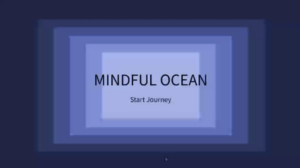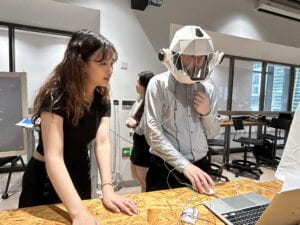III. CONCLUSIONS:
Our project aims to explore the potential benefits of combining mindfulness practices with the calming environment of the ocean. By incorporating tactile, visual, and audio feedback loops, Mindful Ocean encourages participants to incorporate mindfulness practices into their daily routines by playing with the classic mini-game Flappy Bird. We hope to raise ocean protection awareness and nature appreciation as well.
Reflection
Based on our expectations and how our audiences actually interacted with our project, I would say Mindful Ocean provided a decent interactive experience for the audience. They were attracted by our visual settings and fabrication of the wearable installation. Most of the audience said it was fun to interact by breathing and non-touch movements.
One thing we are really proud of is our growing independence with codes. We found example code from Google and class slides; we did 95% of the coding ourselves!
Could’ve done more/better
Nevertheless, due to the limited production time and our poor coding skills and knowledge, despite our best efforts, there are areas of our project that could be further improved to enhance the user experience. Here are some aspects we identified:
Re-operationalizing swimming: Due to the limitations of the ultrasonic sensor, it would be better to explore alternative sensors or re-evaluate the “swimming” mechanism. One potential approach could involve attaching a flexible string between the user’s two arms and measuring the tension or vibration of the string as an input value. This would provide a more stable and accurate interaction method.
Camera capture: We considered implementing a feature that would replace the face of the diver in the game with the user’s own face captured through a camera. However, we did not pursue this idea due to code lag issues and concerns about performance. Nonetheless, it remains an exciting possibility for future development and could add a fun and engaging element to the game.
Visual display elements: In our “Swimming Diver” game, we substituted the traditional pillars in “Flappy Bird” with pink fish, green fish, and grey fish (sharks) that swam horizontally from right to left on the screen. However, we acknowledge that hand-drawn designs and more careful attention to detail could have further enhanced these visual elements. The life bar could have also been improved to achieve a more polished appearance.
Project structure: We improved the project structure by incorporating a starting interface that provides background information and instructions at the beginning of the game. To further improve the overall experience, we recognize the importance of including an ending interface displaying users’ and history highest scores. What’s more, we plan to incorporate impactful messages highlighting the significance of this project in fostering nature appreciation and promoting environmental protection.

Takeaways
Plan ahead: As emphasized by Gohai in our class sessions, the iterative process of designing and production is crucial in project development. Preparing and outlining a solid plan before delving into the intricacies of crafting and coding is paramount to achieving efficiency and success.

Valuing others’ feedback: Recognizing the importance of empathizing with others and acknowledging our own biases, we actively sought and valued the feedback of others. The User Testing sessions and input from our friends provided invaluable insights that guided us in improving our projects. We are super grateful for these genuine and thoughtful contributions, which greatly enhanced the quality of our work.
Code organization: Unlike our Midterm Project, the Final Project had an increased coding complexity, with multiple logic levels and extended code length. So the importance of organizing our code effectively became more apparent, allowing for easier tracking of logic and efficient debugging. To achieve this, we implemented the following strategies:
1. Utilizing flexible global variables, such as “width” and “length,” instead of discrete numerical values. This lesson was learned when I needed to adjust our canvas size to fullscreen, as manually replacing every instance of a number with a global variable proved cumbersome and time-consuming.
2. Dividing our code into distinct blocks, with concise annotations that outline the function and purpose of each code block. This approach facilitated comprehension and navigation, making identifying and resolving any issues easier.
By implementing these practices, we streamlined our coding process and maintain clarity in our project, enabling us to track and refine the logic behind our design effectively.